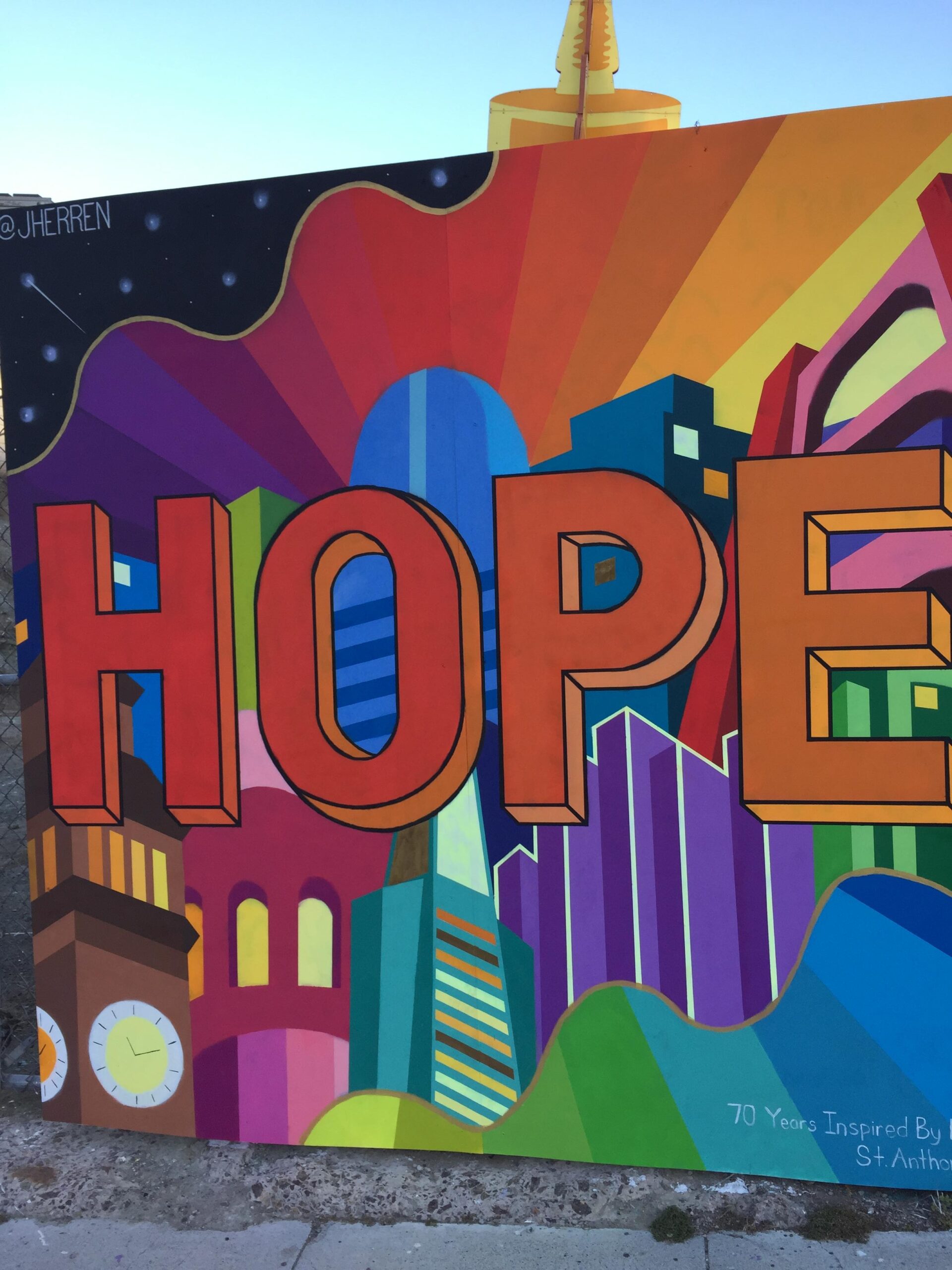 What will you hope for in the coming year?
What will you hope for in the coming year?
Some years ago a college classmate sent me and others this question by way of a year-end holiday missive, ruminating on how hope and optimism are similar yet different. It struck a chord with me (Thank you David Mahoney).
You see, I’m not generally an optimist. Yet I’m often hopeful.
I’d just never taken time to actively consider how these concepts are different. Now I have, and I think it matters.
Especially in times of transition, like the times we’re now in.
So, as we approach critical elections in the U.S., face wars on several fronts throughout the world, look into the eye of the storm (so to speak) as the globe experiences the fallout of changing weather patterns, find ourselves on the brink of revolutionary technological breakthroughs that will significantly impact our lives — not to mention the challenges you and your organization face on a regular basis — I want to share my thoughts with you in this article.
Hope is Active; Optimism is Passive
Optimism and hope are often used interchangeably; they’re not.
“Optimism is the belief that things are going to get better. Hope is the belief that we can make things better. Optimism is a passive virtue; hope is an active one. It takes no courage to be an optimist, but it does need courage to hope.”
“Hope is not costless in the way that optimism is. It carries with it a considerable price. Those who hope refuse to be comforted while the hoped-for outcome is not yet reached.”
— Rabbi Ben Sacks, English religious leader, author and philosopher
Similar thoughts are contained in the writings of the embattled first President of the Czech Republic.
“Hope is a state of mind, not of the world. Hope, in this deep and powerful sense, is not the same as joy that things are going well, or willingness to invest in enterprises that are obviously heading for success, but rather an ability to work for something because it is good.
Hope is definitely not the same thing as optimism. It is not the conviction that something will tum out well, but the certainty that something makes sense, regardless of how it turns out.”
— Vaclev Havel, President, Czech Republic, playwright
When you understand the difference between hope and optimism this way, the question of what you will hope for in the coming year translates to:
What good outcome will you actively work towards in the coming year?
Hope is Not Irrational
Reframing hope as active, not passive, is helpful to me.
I’m expectant it will be helpful to you as well. It’s difficult to be optimistic when the evidence around us is so much to the contrary. Whether it’s a pandemic, climate change, social unrest, inequality, bigotry, hatred, injustice, partisan politics… there are so, so many things it seems hard to avoid, outrun or control. The state of our world today can make optimism seem downright irrational.
But not hope.
With hope you can say: “All these bad things are happening, but I believe… I hope… I can create some good.
And that’s what brings the joy.
Hope Requires Commitment
When I think of the people who inspire me, their hope is combined with commitment to action.
In an interview with Jon Meacham shortly before he died, John Lewis spoke of that kind of hope and what he had seen it accomplish during his lifetime.
“We can move ahead, we can move forward, we can create a multi-racial community, a truly democratic society. I think we are on our way there. There may be some setbacks. But we are going to get there. We have to be hopeful. Never give up, never give in, keep moving on.”
— John Lewis, U.S. Congressman, civil rights activist
Hope does not allow one to sit quietly on the sidelines.
Doing that, and expecting change to happen, is a type of delusion. Nothing comes from nothing, no matter how positive your thoughts. People in Nazi Germany who were quietly optimistic fared worse than those who found the courage to leave. I am lucky to have family members who had the courage to make it out; others were not so fortunate. Trying does not always mean succeeding, but when you “keep moving on,” it improves your chances.
Actively trying is committing to hope.
When you look at the life of Vaclev Havel, who was imprisoned for long stretches following the Russian invasion that crushed the Prague Spring revolt, you would not imagine he would live a life defined by an unshakeable commitment to hope. Yet through his writings, his political dissent, and his leadership as President of first Czechoslovakia and then the Czech Republic, Havel had a “willingness … to work for something because it was good” without regard to “how it turns out.”
Hope Requires Courage
Hope takes a courageous spirit that is unnecessary for optimism.
In his sign-off from the PBS News Hour, Mark Shields spoke of the importance of this spirit to the United States. When asked whether he was optimistic, he responded in a way that shows he was really talking about hope (so what follows are his words, but remember he was spoon fed the word “optimism” by the question he was asked).
“I think optimism is the defining characteristic of America. With the exception of those whose ancestors were here when Columbus arrived or those whose ancestors were brought here against their will in chains, every American is either himself or herself an immigrant or are direct descendants of immigrants. To leave friends and family and familiar surroundings to strike out across the sea or the continent for a place you’ve never been, to live among people you’ve never met, to speak a language in many cases you’ve never heard is an act of enormous courage but it is also a statement of profound optimism.”
— Mark Shields, PBS News Hour
What Does This Mean for Leading Your Nonprofit?
Ask yourself what you are willing to commit to hope for.
Be as bold and courageous as you can be. Consider the ‘good’ that can be accomplished through concerted action, despite the ‘bad’ we see all around us. Don’t despair because you can’t do everything, or even because you can’t do what you could do last year. You still have a job to do.
“You are not obligated to complete the work, but neither are you free to desist from it.”
–– Rabbi Tarfon, Pirkei Avot, Ethics of the Fathers (2:21)
It adds up. The above is one of my favorite quotes, and could almost be a mantra for the social benefit sector. We do what we can, one organization, one community, one family, one person at a time.
It adds up. And even though sometimes we must move two steps backward, we then commit to moving three steps forward. When leaders model this, others follow.
It adds up. Whatever you see that is wrong, even if it is something small, commit this year to actively righting that wrong. Because little wrongs can become big ones. It’s better to nip them in the bud. Develop a plan to put your mind and body into the work to fight whatever is causing your world to be out of balance right now.
Don’t Lose Heart
The philanthropic sector, literally, is the “love of humanity” sector.
Love is an active verb. And sometimes love is hard. You will be disappointed. But that’s not a reason to stop loving. Or to stop coming from a place of love in your interactions with your constituents.
“We must accept finite disappointment, but never lose infinite hope.”
— Martin Luther King Jr.
If I could have a dream for you and for the sector as a whole this year, it would be:
In other words, don’t lose sight of the values that brought you to this work in the first place.
Everything won’t always be smooth sailing. And sometimes you’ll have to be the one who plays the heavy: “When you see something, say something.” But that’s okay, as long as you never lose heart.
Hearts signify hope.
Have you ever noticed how many nonprofits have hearts in their logos? I believe there’s a reason.
When someone says to you “Take heart!” I believe they mean “Be hopeful.”
John Lewis… Martin Luther King Jr.… Vaclev Havel… and so many others lived lives of active hope, recognizing the injustice around them and being willing to put body, mind and soul to work to fight against what was wrong in order to make it right. Since most Americans are descendants of immigrants, many of us have family members who made their way here on active hope, despite the emotional, financial and physical costs.
What Will Bring You Hope and Joy This Year?
What will you actively commit to — knowing the hoped-for outcome may not yet be reached?
What change can you work on that will matter — to those who rely on you and to yourself?
Or if as Lin-Manuel Miranda wrote in Hamilton, America is a “great unfinished symphony” — what composing will you commit to doing this year?
“Every one of us have been warmed by fires we did not build and every one of us has drunk from wells we did not dig. And together we can’t do less for those that come after us, and together we can do so much more. It’s as straightforward as that.”
–Mark Shields
It adds up.
 REMINDER: If part of your hope this year involves getting active to raise more money for your mission, don’t miss out on these easy-to-follow blueprints for success.
REMINDER: If part of your hope this year involves getting active to raise more money for your mission, don’t miss out on these easy-to-follow blueprints for success.
Attitude of Gratitude Donor Guide + Creative Ways to Thank Your Donors
130 full pages jam-packed with the theory and practice of gratitude, one of the most effective yet least effectively utilized donor retention strategies. Includes sample acknowledgement policies & procedures; sample thank you letter templates; sample emails; sample welcome protocols… and more. Plus, you’ll get 72 creative ways to thank your donors.
Major Gifts Playbook
4 Companion Guides with everything you need to know to kick start or rev up your major gifts program. It’s perfect for your small to medium-sized organization, and will help you build a systematic plan for identifying, screening, qualifying and beginning to build relationships with viable prospects before you’re ready to approach them for a gift. Includes hands-on worksheets, exercises and checklists, plus practical tips. Get the full set at a discount (or buy volumes individually).
Anatomy of a Fundraising Appeal + Sample Template
This is a simple, yet incredibly thorough, 62-page step-by-step guide to crafting a killer appeal letter or email appeal. Because writing a compelling fundraising letter can be tricky. It’s not the same kind of writing as a brochure, annual report or grant proposal. it’s something you can easily learn. It’s just not something most of us are taught. If you’re ignoring any of the elements that go into making your appeal effective you’re ignoring your organization’s future.
Year-End Fundraising Solution Kit: To-Do’s + Checklists
This 63- page-long comprehensive road map to effective year-end fundraising is designed to help you increase your year-end impact, and also get a jump on retaining the donors you acquire this year for many years to come. You don’t want to miss making a few tweaks that could mean a big difference in your results. You’ll find a ton of practical tips, great examples and useful checklists!
NOTE: All Clairification products come with a no-questions-asked, 30-day, 100% refund guarantee. If you’re not happy, I’m not happy. My hope these workbooks will genuinely help you is what brings me joy!
#Leading #Nonprofit #Hope #Optimism










